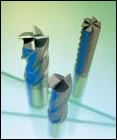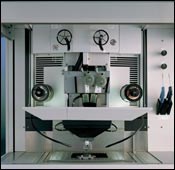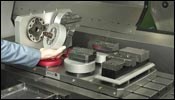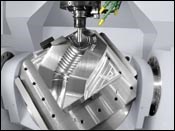Top 10 List
What technologies were instrumental in changing mold manufacturing in the past 10 years?
1. Five-axis machining. Development of five-axis machining coupled with shop floor cutter path programming. Being able to purchase and use five-axis machines helped reduce cutting time.
2. Automation. Automating processes with robots and carousels that load machines allowing lights-out operations and freeing up people to be able to run six machines instead of one. Robotically controlled electrode loading for graphite milling and EDM burning in a single work cell.
3. Coatings. Advances made in coatings for the metals used in tooling, cutters and components.
4. Increased machine and tooling capabilities. Increased spindle speeds, feedrates and contour controls. Software and processing power that has allowed machine tool manufactures to provide equipment of enormous potential, including agile platforms for multi-axis, setup reducing and lights-out fabrication. Improved tooling to interface the machine to the part. Solid carbides, shrink-fit toolholding and on-the-fly tool measurement for diameter, length, wear and run-out. Machine vision has opened new doors for high-speed inspection.
5. Additive fabrication. Development of rapid prototyping
technologies and strategies has been a big assist in fast tool and product construction. Robust, accurate forms and shapes are now fully feasible. New materials, including nanocomposites, have made possible real-life handling and testing that has expedited manufacturing.
6. Non-contact, white light scanning. A photogrammetizing system for 3-D database development, reverse engineering and streamlined inspection capabilities. It can be used for a wide range of applications—from scanning natural textures to obsolete parts where no information was available, to new molds manufactured offshore, where mathematical design information isn’t available. Scanning technology that permits re-engineering at an advanced level, saving huge amounts of engineering time and money.
7. Wire EDM. WEDM changed both the design criteria and the ease of manufacturing deep cavities.
8. Lasers. The use of lasers for mold repair. Benefits include accuracy, resolution and repeatability.
9. High-speed/high-definition hard milling/high-speed CNC machines (steel and graphite). These machining innovations have changed a shop’s approach to mold manufacturing. Through these machine tools the mold builder has been able to greatly reduce or eliminate the use of die sinking EDM. On a related note, milling and EDM have pushed each other to improve as one tries to outpace the other in influencing the moldmaking industry.
10. Software improvements. Advancements in CAD, CAM and PDM applications. CAD/CAM improvements that provide the toolpath to drive the machine and create the improved toolpath to take advantage of the capabilities of tool and machine. CAD systems for CNC machining, CAM systems for designing parts and integrating the two together. Parametric CAD/CAM systems. Built-in intelligent remachining, torchoidal milling and plunge roughing have improved the quality of the programs delivered to the CNC.
An increased level of computer literacy as well as the Internet have contributed tremendously to the improved efficiencies of the mold build process.
This list is compiled from the most popular answers to a reader poll.
Related Content
-
Top 10 Topics to Cover During an ISO 9001 Manufacturing Audit
Take a look at this practical hands-on approach to conducting a quality audit.
-
Making Quick and Easy Kaizen Work for Your Shop
Within each person is unlimited creative potential to improve shop operations.
-
MMT Chats: Solving Schedule and Capacity Challenges With ERP
For this MMT Chat, my guests hail from Omega Tool of Menomonee Falls, Wisconsin, who share their journey with using enterprise resource planning (ERP)—and their people—to solve their schedule and capacity load monitoring challenges.













